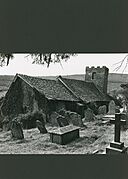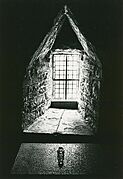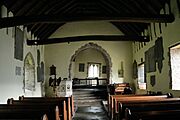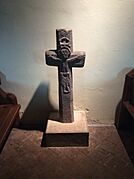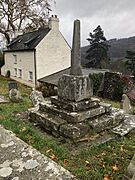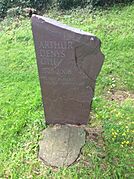St Martin's Church, Cwmyoy facts for kids
Quick facts for kids Church of St Martin, Cwmyoy |
|
|---|---|
| Church of St Martin | |
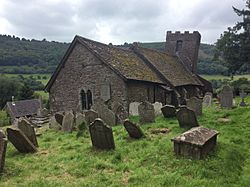
"The most crooked church in Britain"
|
|
| Lua error in Module:Location_map at line 420: attempt to index field 'wikibase' (a nil value). | |
| OS grid reference | SO299233 |
| Location | Cwmyoy, Monmouthshire |
| Country | Wales |
| Denomination | Church in Wales |
| History | |
| Status | Parish church |
| Founded | c.12th century |
| Dedication | St Martin |
| Architecture | |
| Functional status | Active |
| Heritage designation | Grade I |
| Designated | 9 January 1956 |
| Architectural type | Church |
| Administration | |
| Parish | Llanfihangel Crucorney with Oldcastle and Cwmyoy and Llanthony |
| Deanery | Abergavenny |
| Archdeaconry | Monmouth |
| Diocese | Monmouth |
The Church of St Martin in Cwmyoy, Monmouthshire, Wales, is famous for being one of the most tilted buildings in Great Britain. It is often called "the most crooked church in Britain." Building started in the 12th century, but a huge landslide long ago caused the church to twist and lean.
To stop it from falling down, giant wooden beams and stone supports called buttresses were added over the years. The church is built in the Gothic style and is dedicated to St Martin of Tours. Because of its amazing history and unique shape, it is a Grade I listed building. This means it is a very important building that is protected by law.
Contents
Why Is the Church So Crooked?
The church was built on a hillside with unstable ground. The ground is made of a layer of hard Old Red Sandstone on top of a softer rock called marl. Over many centuries, the ground has slowly slipped downhill in a process called a landslide.
This movement started soon after the church was first built. The landslide caused the tower and the main hall of the church to move in different directions, twisting the whole building. You can see signs of old repairs from the Middle Ages, showing that people have been trying to fix the problem for hundreds of years.
In 1887, an architect named J. James Spencer added more buttresses to the outside walls to help hold them up. The goal was not to make the church straight again, but to make it stable and safe. More work was done to strengthen the church in 1991.
Architecture and Design
The Church of St Martin is built from local Old Red Sandstone and has stone-tiled roofs. It has a main hall (the nave), a special area at the front (the chancel), a south porch, and a tower with a castle-like top.
A Leaning Interior
Inside, the crookedness is even more obvious. One writer said that being inside feels like you are "on the deck of a galleon in a storm." The floor, walls, and roof all lean at strange angles. The roof over the nave is very old, dating back to the late 13th or early 14th century.
Some people believe the chancel was built to lean on purpose. This is called a "weeping chancel" and is meant to look like the head of Jesus on the cross, fallen to one side. The church also has beautiful 16th-century windows and a wooden screen that is a "remarkable work of craftsmanship."
The Church Bells
The tower holds six bells, which are very old. They were made between 1672 and 1722. It is rare to find a set of bells this old that were all made so close together in time. However, the bells cannot be rung properly. This is because the tower is too fragile to handle the strong forces created by ringing them, and some of the bells may be cracked.
The Cwmyoy Cross
Inside the church is a special stone cross from the 11th or 12th century. It has a rare carving of Jesus on it. In the Middle Ages, the cross stood outside in the churchyard. It was a holy object for pilgrims who were travelling through the Black Mountains to St David's Cathedral.
During the Reformation, a time of religious change in the 16th century, the cross was buried in the churchyard to keep it safe from being destroyed. It was rediscovered centuries later. In 1967, the cross was stolen but was found in an antique shop in London and returned to the church. Today, it stands on a new stone base inside the church for everyone to see.
The Church Today
St. Martin's is still an active church. It is part of a group of local churches and holds regular services for the community.
In the churchyard, you can see many old gravestones. One modern gravestone is a purple slate pillar that marks the grave of Arthur Denys Gill, a racing car driver who lived and farmed nearby after he retired.
Gallery


